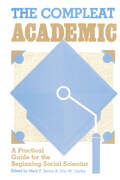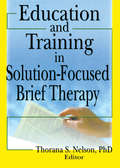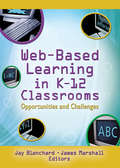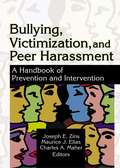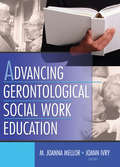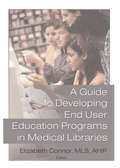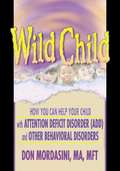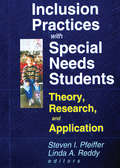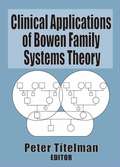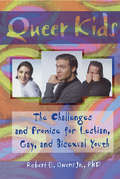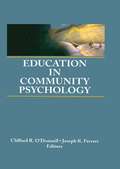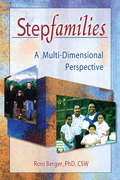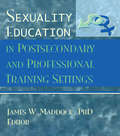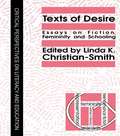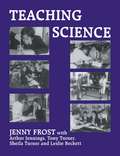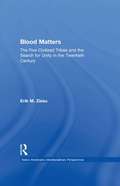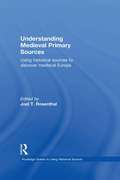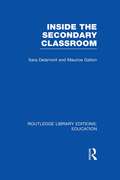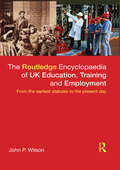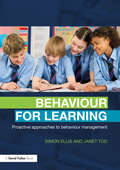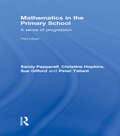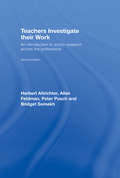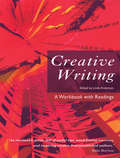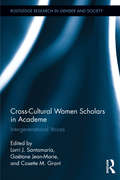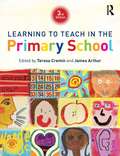- Table View
- List View
The Compleat Academic: A Practical Guide for the Beginning Social Scientist
by Mark P. Zanna John M. DarleyThis volume is a collection of information about the concerns and problems of the beginning social scientist in the academic and nonacademic world. Covering topics from the senior graduate student's job search to the assistant professor's research and teaching experiences, this book serves as an official introduction to the "rules of the academic game".
Education and Training in Solution-Focused Brief Therapy
by Thorana S NelsonThe one-of-a-kind book that provides training exercises illustrating solution-focused brief therapy!As we recognize our own problem behavior in our lives, most of us struggle for ways to change it. Solution-focused brief therapy is the highly effective practice that works by changing concentration from &’problem&’ behavior to &’solution&’ behavior in just a few sessions. Education and Training in Solution-Focused Brief Therapy presents articles, essays, and a multitude of exercises that explain this unique type of therapy with an eye toward helping readers to use the ideas for use in their own training and practice. Detailed descriptions of training workshops and exercises spotlight the experiences of SFBT therapists to illuminate in-depth basic concepts and strategies.Education and Training in Solution-Focused Brief Therapy relies on two fundamental ideas, that of a therapist discovering and reinforcing a clients&’ existing solutions and exceptions to the problem. Expert trainers discuss strategies that work for training and practicing Solution-focused brief therapy. Several exercises for clients are examined, as well as exercises for the training and supervision of other practitioners learning the process. Exercises include The Name Game, the Complaining Exercise, Inside and Outside, the &’Deck of Trumps,&’ and the Solution-Focused Scavenger Hunt. Each chapter explains the circumstances in which to use each exercise, the best ways to enhance effectiveness, and how to stay on track in the teaching or training. This one-of-a-kind book includes helpful tables, thorough questionnaires, penetrating case studies, and each chapter is extensively referenced.Education and Training in Solution-Focused Brief Therapy discusses brief therapy principles such as: negotiating goals engagement through complimenting future orientation language should be imaginative and positive explanations and actions taken to solve problems are interconnected challenging the perceived causes of problems reframing the problem so that it becomes a friend acknowledgement and acceptance of clientEducation and Training in Solution-Focused Brief Therapy brings together essential ideas, suggestions, strategies, and exercises for solution-focused brief therapy training, making this an invaluable resource for solution-focused brief therapists and therapists who teach and train this form of therapy.
Web-Based Learning in K-12 Classrooms: Opportunities and Challenges
by James Marshall Jay BlanchardMake sure your students get the most from their online learning experiencesEven though nearly every K-12 public school in the United States has broadband Internet access,the Web&’s vast potential as a teaching and learning tool has still not been realized. Web-based learning opportunities have been expensive, slow to develop, and time-consuming to implement, despite pressure on schools to adopt technology solutions that will cure their educational ills. Web-Based Learning in K-12 Classrooms: Opportunities and Challenges chronicles the up and downs of online learning and offers unique insights into its future, providing a comprehensive, curriculum-wide treatment of K-12 content areas (reading, science, mathematics, social studies), special education, counseling, virtual schools, exemplary schools, implementation issues, and educational Web sites.The Internet represents a powerful, complex set of technologies that offers your students access to unlimited knowledge-but that access doesn&’t replace the human interactions found in classrooms. Placing a student in front of a computer monitor is a supplement to classroom learning, not a substitute for it. Academics and education professionals address questions surrounding the key issues involved in successfully incorporating the wide range of Web-based learning opportunities (formal courses, demonstrations, simulations, collaborations, searches) into the classroom, including technology, content, and implementation.Web-Based Learning in K-12 Classrooms examines: inquiry-based learning online interaction displaying student work online Internet accessibility for students with disabilities initiating school counselors into e-learning technologies the role of government in virtual schools Web-based schools in California, Virginia, Pennsylvania, Vermont, and Texas a 13-category classification system for online educational resources the ATLAS model for program implementation evaluations of more than 1,000 pieces of online information (articles, research, reports, news, and statistics) and 900 Web applications (tutorials, drills, games, and tests) with evaluation criteriaWeb-Based Learning in K-12 Classrooms is a vital resource for educators interested in online learning applications across the K-12 curriculum.
Bullying, Victimization, and Peer Harassment: A Handbook of Prevention and Intervention
by Charles A Maher Joseph Zins Maurice EliasA comprehensive examination of theory, research, prevention and intervention, and professional practice issues - in one source. Teasing, shunning, and bullying can have serious detrimental effects on both victim and perpetrator. Bullying, Victimization, and Peer Harassment: A Handbook of Prevention and Intervention comprehensively gathers emerging research, theory, and effective practice on this subject into one invaluable source. This thorough review of a wide spectrum of innovative, evidence-based practices targets the complex problems of victimization, peer harassment, and bullying in our schools. Interventions range from individuals and their peers to broad, systems-level change within schools and communities. The challenge of prevention is also explored, using the latest studies as a practical foundation. Suggestions are provided detailing effective strategies to make changes in the culture within schools while offering directions for future research and practice.Bullying, Victimization, and Peer Harassment discusses research on current intervention programs now in place that, until now, has never been evaluated. Several of the studies address middle school issues and multi-ethnic populations, including those from the United States, Canada, and Europe. Peer sexual harassment and dating-related aggression are examined that includes and goes beyond traditional views of bullying and peer intimidation. This valuable handbook provides concise yet extensive information on the most current theory, empirical research, practice guidelines, and suggestions for preparing schools for programmatic initiatives.Topics in Bullying, Victimization, and Peer Harassment include: theory and conceptual issues in victimization, bullying, and peer harassment assessment results from a four-year longitudinal study on peer victimization in early adolescents youth perceptions toward bullying high school students’ victimization profiles immigrant children and victimization evaluating an adolescent violence prevention program a school-based intervention program peer group intervention interventions for victims multiple perspectives involving sexual harassment school-wide approaches to prevention and intervention and much more! Bullying, Victimization, and Peer Harassment is a crucial resource for researchers and mental health professionals who work in schools and who work with children and their families, such as school psychologists, counselors, clinical child psychologists, social workers, and community psychologists.
Advancing Gerontological Social Work Education
by Joanna Mellor Joann Ivrys your gerontological social work program as comprehensive-and as well attended-as it could be? Advancing Gerontological Social Work Education will help you develop courses that effectively prepare social work students and practitioners to work with the ever-increasing older population. It clearly presents the rationale for geriatric/gerontological preparation and defines the current status of geriatric/gerontological education. With fascinating case studies, detailed curricula, and a review of the skills and knowledge competencies necessary for effective geriatric social work practice, this book also describes a variety of courses and teaching programs in detail-noting the problems that other educators have encountered and offering practical suggestions to help in replicating the programs in other institutions. This book is especially useful because it not only examines the issues surrounding-and need for-increased gerontological education for social workers, but because it follows this with specific, concrete descriptions of educational approaches and curricula. It provides you with both the framework and the specifics to develop your own gerontological social work education program at the graduate or undergraduate level. Helpful charts and tables make the information easy to access and understand. Advancing Gerontological Social Work Education is divided into three sections, each of which will increase your knowledge and understanding of this vital area of social work education. The first section examines: the historical development of gerontological social work education the CSWE/SAGE-SW Competencies Project the importance of interdisciplinary teamwork-and the educational basis for interdisciplinary team training, highlighting organizational context, team structure, team process, and team outcomes ways to increase students' interest in this vital area of social work In the second section of this well-referenced book, you will examine school-based initiatives, focusing on: the development and implementation of the John A. Hartford Foundation Geriatric Social Work Initiative the recruitment of students into geriatric social work-with an examination of a fellowship program the relationship between the aging population of the United States and the growing demand for geriatric social workers-and how that need can be met through graduate-level social work training developing a field training rotation model a doctoral fellowship program and its dissertation support, mentorship, and leadership development The third section of Advancing Gerontological Social Work Education features: an empirical study exploring the potential for a limited curriculum module to enhance MSW and BSW students' gerontological practice-related knowledge, attitudes, and interest an overview of the history and rationale of service learning in elder care a description of the varied service learning in elder care programs an experiential exercise that was used successfully to assist graduate students in integrating and applying their knowledge about geriatric assessment the results of interviews with MSW students about the appropriateness of their preparation for medical social work with an aged population-conducted at the beginning, midpoint, and end of their field placements a report on incorporating intergenerational service learning into an undergraduate introductory gerontology course the use of the "family study," which exposes teams of students for 20 weeks to a family that includes an older adult
A Guide to Developing End User Education Programs in Medical Libraries
by Elizabeth ConnorExplore a wealth of ideas, insights, and approaches that can be used or adapted by any medical library!Curricular changes in the health professions, coupled with a growing acceptance of the Internet as a tool for daily living, have contributed to a climate of change and opportunity for health sciences libraries. A Guide to Developing End User Education Programs in Medical Libraries will help graduate students in library science, entry-level medical librarians, and experienced educators to understand best practices and to build, expand, and improve medical library-sponsored educational programs. A Guide to Developing End User Education Programs in Medical Libraries is designed to aid and inform professionals who develop, teach, or evaluate end-user education programs in health sciences libraries. Eighteen case studies represent the ideas and approaches of more than fifteen private and public institutions in the United States and the Caribbean. The studies focus on effective end-user programs for medical information electives, veterinary medicine programs, health care informatics, and evidence-based medicine, plus instructional programs for teaching residents, ThinkPad-facilitated instruction, and more. The guide also examines how several medical libraries have created and expanded their end-user education programs.The contributors to A Guide to Developing End User Education Programs in Medical Libraries are health sciences librarians from teaching hospitals, medical/dental/veterinary schools, and health professions-focused universities in a dozen U.S. states and the West Indies. Each of them is involved in designing, teaching, and evaluating user education. This book will help you educate students of medicine, pharmacy, physical therapy, dentistry, and veterinary medicine, plus residents and practicing health professionals. The educational objectives and approaches in the case studies include: clinical medical librarianship integrating informatics objectives into curricula developing credit and non-credit coursework distance learning using new and emerging technologies to improve instructionThe case studies in A Guide to Developing End User Education Programs in Medical Libraries follow a format similar to that of the structured abstract, including introduction, setting, educational approaches, evaluation methods, future plans, conclusion, and references. Some are illustrated with tables and figures. Several are supplemented by material in chapter-specific appendixes. Further information about specific classes, programs, or teaching philosophies is made available via Web sites featured in the book.Let this valuable guide help you-and your institution-take advantage of the opportunities available at this exciting time in the evolution of library science!
Wild Child: How You Can Help Your Child with Attention Deficit Disorder (ADD) and Other Behavioral Disorders
by Don MordasiniHow can you help the ADD child in your life?Attention deficit disorder (ADD) is one of the most discussed yet least understood childhood disorders today. Here is a book that delivers the answers people are looking for!Wild Child explains the symptoms, thinking patterns, and behavior of children and adolescents with ADD in terms that are understandable by parents and grandparents, yet relevant to the professionals who deal with these children. It outlines specific strategies that you can use to cope with the vast array of behavior, hyperactivity, and inattention problems experienced by children with ADD. The concepts outlined in Wild Child will show you how to bond more closely with children who tend to alienate them, and help children feel better about themselves, aiding them in their quest to master their specific challenges. Because this book is written from the inside, explaining what the symptoms feel like from the perspective of someone with ADD as well as from the perspective of someone with an ADD child, readers will easily identify with the author.This valuable book will help you and the ADD child in your life by helping you to: build your personal confidence in dealing with ADD children and teens through knowledge and understanding deal with specific problems in your family or patients build esteem and sound emotional infrastructures in ADD children and empower them to take control of their livesWild Child features: tables and motivational charts that illustrate how to work with an ADD child checklists that adults can use if the suggested interventions fail with a particular childADD is truly a hidden disability, and the children suffering with it are usually labeled wild, crazy, or stupid. This, of course, leads to low self-esteem and underachievement, but Wild Child stresses that new learning can and does take place when proper motivators are applied. This book provides concrete advice regarding what those motivators are and how and when to use them. Teaching adults to empower the children in their care is an important part of Wild Child. Without appropriate intervention, children with ADD frequently end up chemically addicted or in trouble with the law. This book can help prevent these things from occurring. This is a valuable resource for everyone who knows a child with ADD.
Inclusion Practices with Special Needs Students: Education, Training, and Application
by Steven I Pfeiffer Linda A ReddyExplore the challenges, opportunities, and pitfalls of the inclusion of students with disabilities in your classroom!Exciting, complex, and challenging shifts in American education are occurring today. First, schools are moving to embrace student diversity and accommodate the classroom experience to support diverse ways of organizing students for learning. Second, teachers are moving away from a traditional didactic instructional mode and embracing a facilitator role that encourages creating innovative classroom learning opportunities. Third, there is a shift from the view of the school as providing educational and psychoeducational services for students to providing educational supports for learning.Coinciding with these changes is the growing movement in special education that enourages full inclusion of students with special needs. This is a far cry from the exclusionary and separatist movements of special education less than twenty years ago. Now American education is facing the challenging situation of working with students with disabilities in the regular classroom. Inclusion Practices with Special Needs Students provides a much needed overview of the issues faced by educators committed to understanding how to best serve children with disabilities in schools.Inclusion Practices with Special Needs Students: Theory, Research, and Application provides an overview of the origins, evolution, and recent developments regarding the inclusion of students with disabilities into general education classrooms. The book critically challenges the overriding assumptions that support the philosophy of inclusion with a balanced presentation or research and theory that both supports and raises questions about the viability of this practice. The contributors are authorities in their respective areas of inclusionary practices.Some of the issues you will explore in Inclusion Practices with Special Needs Students are: political, fiscal, and legal events that have shaped inclusion practices implications for school psychologists handling students with serious emotional, behavioral, or developmental problems remaining in regular education agenda for future research priorities for research, training, and policy reformInclusion Practices with Special Needs Students addresses practical, psychoeducational, philosophical, legal, ethical, and financial issues surrounding the inclusionary initiative in special education.
Clinical Applications of Bowen Family Systems Theory
by Peter TitelmanOne look inside Clinical Applications of Bowen Family Systems Theory, and you’ll see that your most current clinical dilemmas are not as difficult to solve as you think. You’ll find plenty of information to assist you in treating a vast audience of populations--the elderly, college students, troubled couples, remarried families, and children with severe medical problems. You’ll also find that you’re able to apply the Bowen systems theory to nearly every clinical situation--emotional dysfunction in children, alcoholism, incest, divorce, depression, phobias, and obsessive-compulsive disorders.Clinical Applications of Bowen Family Systems Theory is an ideal companion for family therapists, clinical psychologists, clinical social workers, psychiatrists, psychiatric nurses, and counselors. You’ll find your working comprehension of Murray Bowen’s work will grow, and you’ll become more adept at applying what you read in real-life clinical situations, especially in these related areas: family systems assessment based on the Bowen Theory marital fusion and differentiation bridging emotional cut-off from a former spouse dealing with a child-focused divorce case studies of alcoholism and family systemsClinical Applications of Bowen Family Systems Theory is the first book to collect, illustrate, and walk you through a full application of this highly effective treatment method in any number of clinical settings. Both beginning and experienced therapists will find interesting reading in the history of the theory, and the result will be interested clients who begin to create functional, thriving personal histories for themselves.
Queer Kids: The Challenges and Promise for Lesbian, Gay, and Bisexual Youth
by Robert E OwensPacked to the hilt with living narratives, scholarly research, and problem-solution scenarios, Queer Kids: The Challenges and Promise for Lesbian, Gay, and Bisexual Youth examines the unique challenges faced by today’s homosexual young adults. You’ll learn what modern-day queer kids do to cope, survive, and find understanding in a world riddled with homophobic intolerance. Queer Kids is a lens of clarity that will help the average straight adult--and maybe even the average gay adult--see things from a kid’s point of view. Its detail-oriented, well-wrought chapters will provide you with literally hundreds of stories of young people who are trying to define themselves sexually and emotionally in a society of criss-crossing judgment, stereotyping, anger, and expectation. Aimed at three target groups--counselors, parents, and youth--this book introduces you to a variety of interesting kids, offers you a look at the process of coming out, and helps you grasp the experience of queer identification. Specifically, you’ll read about: queer kids and their families and peers the medical/health care profession’s impact on queer kids the teachers and counselors of gay, lesbian, and bisexual youth how to alleviate harrassment, abuse, withdrawal, and loneliness the effects of familial denial, prejudiced counselors, and standoffish gay adultsBeing a kid is tough--but being a queer kid can be even tougher. Fortunately, Queer Kids is available for students, ministers, teachers, youth- and health-care workers, and especially the friends and families of teens who are working through the personal turbulence that too often accompanies sexual and emotional definition. Guided by its upfront approach and practical resource list of written, computer, and telephone aids, you’ll see that a solution is not as distant as you think. Read it, and relearn what it means to be a kid again.
Education in Community Psychology: Models for Graduate and Undergraduate Programs
by Joseph R Ferrari Clifford R O'DonnellA useful guide on education in the field of community research and action, Education in Community Psychology explores curriculum issues regarding coursework, field training, the status of research, and the need for promoting a multidisciplinary perspective. For your easy reference, it gives you a thorough overview of the kinds of undergraduate and graduate courses available and of freestanding and interdisciplinary graduate programs in both North America and New Zealand. For your convenience, it also covers the types of knowledge and skills taught in these courses and programs, the professional roles open to community graduates, how programs can work with community organizations, and the steps and issues you should consider when planning a community psychology course or program. From this book’s helpful pages, you will discover why interdisciplinary programs hold the most promise for innovation in graduate education, as well as the greatest potential for developing community research and action into an interdisciplinary field. If you are interested in setting up a program that helps students develop a ‘systems perspective’in the way they approach problems and issues in the community, Education in Community Psychology will help you get started. To this end, you learn about: the issues and strategies in teaching community psychology to your students practical steps for developing your program how to secure viable field placements for your students how your community psychology program can train psychologists in nontraditional roles suited to address human and social problems the ecology of masters’programs selecting required readings trends in interdisciplinary training using social functions that include faculty, students, and community agencies to develop collaborative working relationships the change in APA guidelinesEducation in Community Psychology provides community psychology professors and graduate students, psychology undergraduates intending to go to graduate school, and educators in human development and social work with a practical overview of the field of community research and action, its values, ethics, theories, and methods. With its sample course outlines, recommendations for faculty planning, and insights on how to develop community psychology programs, you will be able to extend your skills beyond the classroom and into the community, where it counts.
Stepfamilies: A Multi-Dimensional Perspective
by Roni BergerCombining theoretical, empirical, and clinical knowledge, Stepfamilies: A Multi-Dimensional Perspective contains recent research and information that will help mental health practitioners, family therapists, psychologists, and counselors understand the characteristics, dynamics, needs, and issues of nonclinical stepfamilies. Based on direct experiences with diverse types of stepfamilies, this book gives you new guidelines and strategies that will enable you to offer more successful sessions to your clients and improve your effectiveness as a practitioner. Developed to give you a more realistic understanding of stepfamilies, this text helps you avoid the stereotypes and false perceptions that often surround stepfamilies. Offering methods and strategies aimed at making your clients feel comfortable about themselves and their situations, Stepfamilies: A Multi-Dimensional Perspective examines several aspects of these families that you need to know in order to improve your effectiveness with them, including: the definition and description of stepfamilies and recognizing historical and social changes in the stepfamily structure critical reviews on the present knowledge of stepfamilies describing the complexity of family structure, the ambiguity of boundaries and roles, and the struggle with the diverse phases of the life cycle discussing key issues for stepfamilies, such as past orientation and acceptance/rejection of differences from non-stepfamilies and focal subsystems the profile, characteristics, and case studies of an innovative typology of stepfamilies that includes integrated families, invented families, and imported families aspects of ethnically and culturally different stepfamilies, including American stepfamilies, Israeli stepfamilies, and immigrant stepfamilies from the former Soviet Union social perceptions and attitudes of stepfamilies in schools, social services, community organizations, the media, and with the lawOffering case studies and data on a variety of families and situations, Stepfamilies: A Multi-Dimensional Perspective will show you that all stepfamilies are not the same and cannot be helped by just one practice method. Complete with principles and instruments to assess patients and the success of sessions, Stepfamilies: A Multi-Dimensional Perspective works to promote an understanding of stepfamilies that will result in effective and positive therapy for your clients.
Sexuality Education in Postsecondary and Professional Training Settings
by James Wm MaddockSexuality Education in Postsecondary and Professional Training Settings keeps you up-to-date on the trends and issues in sexuality education in colleges, universities, and professional training institutions. A diverse group of authors, all experienced sexuality educators, offers summary information, critical commentary, thoughtful analysis, and projections of future trends in sexuality education in postsecondary settings. This keeps you current on the status of sexuality education and will move you to consider a variety of concerns and challenges in designing and implementing sexuality education courses and programs. Finally, the chapters present you with valuable resources, ranging from historical references to contemporary website information.Beginning with an historical perspective on twentieth-century sexuality education, Sexuality Education in Postsecondary and Professional Training Settings includes information on the nature and extent of sexuality education in contemporary colleges and universities, as well as in institutions training teachers, clergy, and physicians. The book's expert authors analyze undergraduate curricular and pedagogical issues, as well as problems in classroom climate and the challenges of meeting objectives for behavioral change. Specific topics you learn about include:guidelines for teaching undergraduate sexuality courses--with a focus on philosophical issues; how to develop objectives and implement teaching strategies; print, media, and Internet resources for teaching; and commentary on controversial issues effects of various workshops on the contraceptive-related attitudes and behaviors of college studentssexuality education and HIV/AIDS prevention education in teacher preparation institutionsperceptions of faculty regarding curriculum and approaches to sexuality education in clergy training institutionssexuality education in medical school curricula in the U.S. and Canada Sexuality Education in Postsecondary and Professional Training Settings is a valuable guide for sexuality educators in postsecondary settings and educators in corollary areas such as health education, educational psychology, family education, or curriculum development. Also an informative and useful text for scholars, researchers, professionals, and students in the fields of sexuality education, behavioral sciences, applied social sciences, and social policy, this book presents a variety of philosophical and methodological approaches to vital issues, ranging from qualitative phenomenological and interpretive methods to quantitative analyses to critical essays.
Texts Of Desire: Essays Of Fiction, Femininity And Schooling
by Linda K. Christian-SmithFirst published in 1993. Routledge is an imprint of Taylor & Francis, an informa company.
Teaching Science
by Jenny Frost Richard B. IngleFirst published in 1995. Routledge is an imprint of Taylor & Francis, an informa company.
Blood Matters: Five Civilized Tribes and the Search of Unity in the 20th Century (Native Americans: Interdisciplinary Perspectives)
by Erik March ZissuThis study explores how the five tribes of Oklahoma - Cherokees, Chickasaws, Choctaws, Creeks, and Seminoles - strove to achieve political unity within their tribes during the first decades of the 20th century by forging a new sense of peoplehood around the idea of blood.
Understanding Medieval Primary Sources: Using Historical Sources to Discover Medieval Europe (Routledge Guides to Using Historical Sources)
by Joel T. RosenthalMedieval society created many kinds of records and written material which differ considerably, giving us such sources as last wills, sermons, manorial accounts, or royal biographies. Primary sources are an exciting way for students to engage with the past and draw their own ideas about life in the medieval period. Understanding Medieval Primary Sources is a collection of essays that will introduce students to the key primary sources that are essential to studying medieval Europe. The sources are divided into two categories: the first part treats some of the many generic sources that have been preserved, such as wills, letters, royal and secular narratives and sermons. Chapter by chapter each expert author illustrates how they can be used to reveal details about medieval history. The second part focuses on areas of historical research that can only be fully discovered by using a combination of primary sources, covering fields such as maritime history, urban history, women’s history and medical history. Understanding Medieval Primary Sources will be an invaluable resource for any student embarking on medieval historical research.
Inside the Secondary Classroom (Routledge Library Editions: Education)
by Sara Delamont Maurice GaltonFocusing on pupils moving from primary to middle or secondary school, it describes and evaluates the schools’ programmes to ease transfer, and includes material provided by the pupils themselves. The main body of the book is a rich and detailed account of the first months of life in new secondary schools, where the pleasures and perils of new friends, new teachers and new subjects, and a new approach to teaching are encountered. The book conveys vividly how pupils experience a new environment, and meet its dangers, rules and regulations, timetable, complex groupings and ideology. Inside the Secondary Classroom was the first comparative ethnography of school life in Britain, carried out in six schools. It reveals surprising similarities and differences between them.The cases studied range from highly successful pupils with nine ‘O’ levels to others with severe social and personal problems.
The Routledge Encyclopaedia of UK Education, Training and Employment: From the earliest statutes to the present day
by John P. WilsonA comprehensive guide to all the main labour market initiatives and agencies combining education and employment in the UK, this encyclopaedia presents an historical progression from the Guilds and Statute of Artifices in 1563 through to present day initiatives and changes. Fully cross-referenced throughout, with a full list of acronyms, bibliographic and internet resources, the encyclopaedia includes: Detailed descriptions of all major government initiatives connecting education, training and employment Documentation covering England, Northern Ireland, Scotland and Wales, and initiatives in Ireland up to Irish independence A brief history of education and employment in the UK Chronological history of Government Departments Outlines of all major public agencies and qualifications An extensive glossary of acronyms Information on rarely recorded and inaccessible historical documents With over 1500 entries, this encyclopaedia crosses knowledge boundaries providing for the first time an integrated map of national human capital development. It addresses: preschool initiatives, primary, secondary, further and higher education; vocational education and training; labour market interventions including those designed to return people to employment; and, government strategies designed to enhance economic and technological competitiveness. The cross-referenced structure provides connections to associated items and a chronological tracing of agencies and initiatives. This encyclopaedia will appeal to those involved in all aspects of education, training, employment, careers information, advice and guidance; and policy making.
Behaviour for Learning: Proactive Approaches to Behaviour Management
by Simon Ellis Janet TodBehaviour for Learning offers teachers a clear conceptual framework for making sense of the many behaviour management strategies on offer, allowing them to make a critical assessment about their appropriateness and effectiveness in the classroom. Teachers need to be asking themselves the question "How can I improve a child’s learning?" rather than "How can I get them to behave?" The authors present a unique focus on the relationships which underpin learning, placing an emphasis on the development of ‘learning behaviours’, and endorses OFSTED’s view that it is essential to evaluate the efficacy of behaviour management against progress in learning. Essentially, this book will help teachers: decide what strategy is best for individuals in their classroom be aware of the evidence / theoretical base that underpins that strategy use be able to evaluate the effectiveness of that strategy. Located within emerging agendas for improved individual holistic outcomes and increased partnership working, this book seeks to synthesise the practical with the theoretical. Authoritative and timely, Behaviour for Learning is compelling reading for all trainees and practicing teachers, CPD coordinators and other professionals working with challenging pupils.
Mathematics in the Primary School: A Sense of Progression
by Sandy Pepperell Christine Hopkins Sue Gifford Peter TallantNow in its third edition, Mathematics in the Primary School has been updated to reflect recent mathematics curriculum documentation and revised standards for QTS. Key areas include: The role of talk in learning maths Teacher questioning Development of children’s reasoning Creative engagement with maths Assessment for learning and self assessment Suggested resources for teachers including ICT Providing a coherent set of principles for teaching primary mathematics across the main topics in the curriculum, the authors explore children’s understanding of key areas of mathematics, at reception, infant and junior levels. Important principles and teaching approaches are identified, including the use of calculators and computers, and there is an emphasis on mental mathematics and problem solving supporting key issues raised by the Williams review (2008). Case studies are used throughout to illustrate how different teaching approaches are put into practice and how children respond to them, and there is advice on planning, organisation and assessment of mathematical learning in the classroom. Emphasising the importance of teachers’ own mathematical knowledge and offering clear guidance and practical advice, this book is essential reading for students, NQTs and practising teachers with a focus on primary mathematics.
Teachers Investigate Their Work: An introduction to action research across the professions
by Herbert Altrichter Allan Feldman Peter Posch Bridget SomekhTeachers Investigate Their Work introduces the methods and concepts of action research through examples drawn from studies carried out by teachers. The book is arranged as a handbook with numerous sub-headings for easy reference and fourty-one practical methods and strategies to put into action, some of them flagged as suitable `starters'. Throughout the book, the authors draw on their international practical experience of action research, working in close collaboration with teachers. It is an essential guide for teachers, senior staff and co-ordinators of teacher professional development who are interested in investigating their own practice in order to improve it.
Creative Writing: A Workbook with Readings
by Linda AndersonCreative Writing is a complete writing course that will jump-start your writing and guide you through your first steps towards publication. Suitable for use by students, tutors, writers’ groups or writers working alone, this book offers: a practical and inspiring section on the creative process, showing you how to stimulate your creativity and use your memory and experience in inventive ways in-depth coverage of the most popular forms of writing, in extended sections on fiction, poetry and life writing, including biography and autobiography, giving you practice in all three forms so that you might discover and develop your particular strengths a sensible, up-to-date guide to going public, to help you to edit your work to a professional standard and to identify and approach suitable publishers a distinctive collection of exciting exercises, spread throughout the workbook to spark your imagination and increase your technical flexibility and control a substantial array of illuminating readings, bringing together extracts from contemporary and classic writings in order to demonstrate a range of techniques that you can use or adapt in your own work. Creative Writing: A Workbook with Readings presents a unique opportunity to benefit from the advice and experience of a team of published authors who have also taught successful writing courses at a wide range of institutions, helping large numbers of new writers to develop their talents as well as their abilities to evaluate and polish their work to professional standards. These institutions include Lancaster University and the University of East Anglia, renowned as consistent producers of published writers.
Cross-Cultural Women Scholars in Academe: Intergenerational Voices (Routledge Research in Gender and Society #41)
by Lorri J. Santamaría Gaëtane Jean-Marie Cosette M. GrantThis ground-breaking collection features the diverse voices, experiences, and scholarship of cross-cultural women of American Indian, Asian American, Black/African American and Hispanic descent at various levels of academe, actively engaged in the advancement of marginalized groups in the U.S. and abroad through their scholarly work. Intergenerational cross-cultural scholars manifest a literary community that models ways in which women scholars can move beyond traditional institutional, psychological, and professional barriers to practice activism, break unwritten rules, and shatter status quo ‘business as usual’ practices in the academy. This distinctive volume exemplifies the phenomenon of cross-cultural women scholars conducting research and writing about ways in which they negotiate their professional realities toward professional goal attainment. Each chapter presents rigorous ethnographic research complemented by critical analyses, reflecting ways in which these self-determined scholars transcend barriers associated with the dynamic intersections of race, gender, ethnicity, class and language in higher education. Scholars share strategies for institutional, psychological, and professional barrier transcendence through various approaches such as educational leadership for equity, the practice of cross-cultural competence, various mentoring interactions, and the creation of and participation in networking groups with other women of color in academe. Students, academics, educational practitioners and individuals seeking exemplars for ethnographic research will find this critical book essential as a means for better informing their scholarship.
Learning to Teach in the Primary School (Learning to Teach in the Primary School Series)
by Teresa Cremin James ArthurFlexible, effective and creative primary school teachers require subject knowledge, an understanding of their pupils and how they learn, a range of strategies for managing behaviour and organising environments for learning, and the ability to respond to dynamic classroom situations. This third edition of Learning to Teach in the Primary School is fully updated with reference to the new National Curriculum, and has been revised to provide even more practical advice and guidance to trainee primary teachers. Twenty-two new authors have been involved and connections are now made to Northern Irish, Welsh and Scottish policies. In addition, five new units have been included on: making the most of your placement play and exploration in learning behaviour management special educational needs phonics. With Masters-level reflective tasks and suggestions for research-based further reading, the book provides valuable support to trainee teachers engaged in learning through school-based experience and through reading, discussion and reflections as part of a teacher education course. It provides an accessible and engaging introduction to knowledge about teaching and learning that every student teacher needs to acquire in order to gain qualified teacher status (QTS). This comprehensive textbook is essential reading for all students training to be primary school teachers, including those on undergraduate teacher training courses (BEd, BA with QTS, BSc with QTS), postgraduate teacher training courses (PGCE, SCITT) and employment-based teacher training courses (Schools Direct, Teach First), plus those studying Education Studies. This textbook is supported by a free companion website with additional resources for instructors and students and can be accessed at www.routledge.com/cw/Cremin.
